Hunger and Starvation Across the World is Affecting Half of Human Race
Hunger and starvation across the world have ravaged mankind since the beginning. Half of the human population still suffers from it; over 820 million people are in the grasp of this debilitating crisis, with millions more under its threat owing to the current coronavirus pandemic and climate change.
The perilous cycle of hunger passes from one generation to the next. Families who struggle with chronic hunger and malnutrition consistently go without the nutrients their minds and bodies need, which then prevents them from being able to perform to their best abilities.
While hunger and starvation persist in many parts of the world, two continents alone, Africa and Asia house more hungry and malnourished people than anywhere else in the world that starve to death each year.
Although Africa is portrayed through various mediums as the epicenter, Asia has always had more hungry people. More malnourished children can be found in the continent, since Asia has such a huge population.
The number of hungry people in the world is growing at an alarming rate. Hunger and starvation across the world have been on tfamhe rise for the past few years – especially owing to the climate change crisis that has exacerbated the already dwindling food security – returning to levels from a decade ago.
This reversal in progress clearly sends a message to do more and urgent efforts if the Sustainable Development Goal (SDGs) of Zero Hunger is to be acquired by 2030.
The situation has considerably worsened in South America and most regions of Africa, while the characterizing trend of undernourishment in Asia – which saw a downward move some time ago – is also threatening many lives, especially of children.
According to the World Health Organization (WHO) statistics, Asia has over 515 million hungry people, Africa has over 250 million, and Latin America and the Caribbean account for nearly 40 million hungry people.
Table of Contents
Long History of Hunger and Starvation
Underdeveloped nations have been facing the foes of hunger and starvation across the world for far too longer than one could imagine.
Africa’s major food crises show conditions still faced by many Africans today – poverty, drought, conflict, and environmental degradation owing to overgrazing, deforestation, and other types of environmental damages.
A drought from 1968 to 1980 in the Sahel region led to 1 million deaths in Mali, Chad, Niger, Mauritania, and Burkina Faso. In the following two years, drought and conflict led to widespread hunger in Uganda.
The famine in Ethiopia in 1984-85 led to about 1 million deaths and massive displacement activities owing to drought in the northern highlands and problems in delivering help. In 1991-92, drought and civil war caused the Somalia famine.
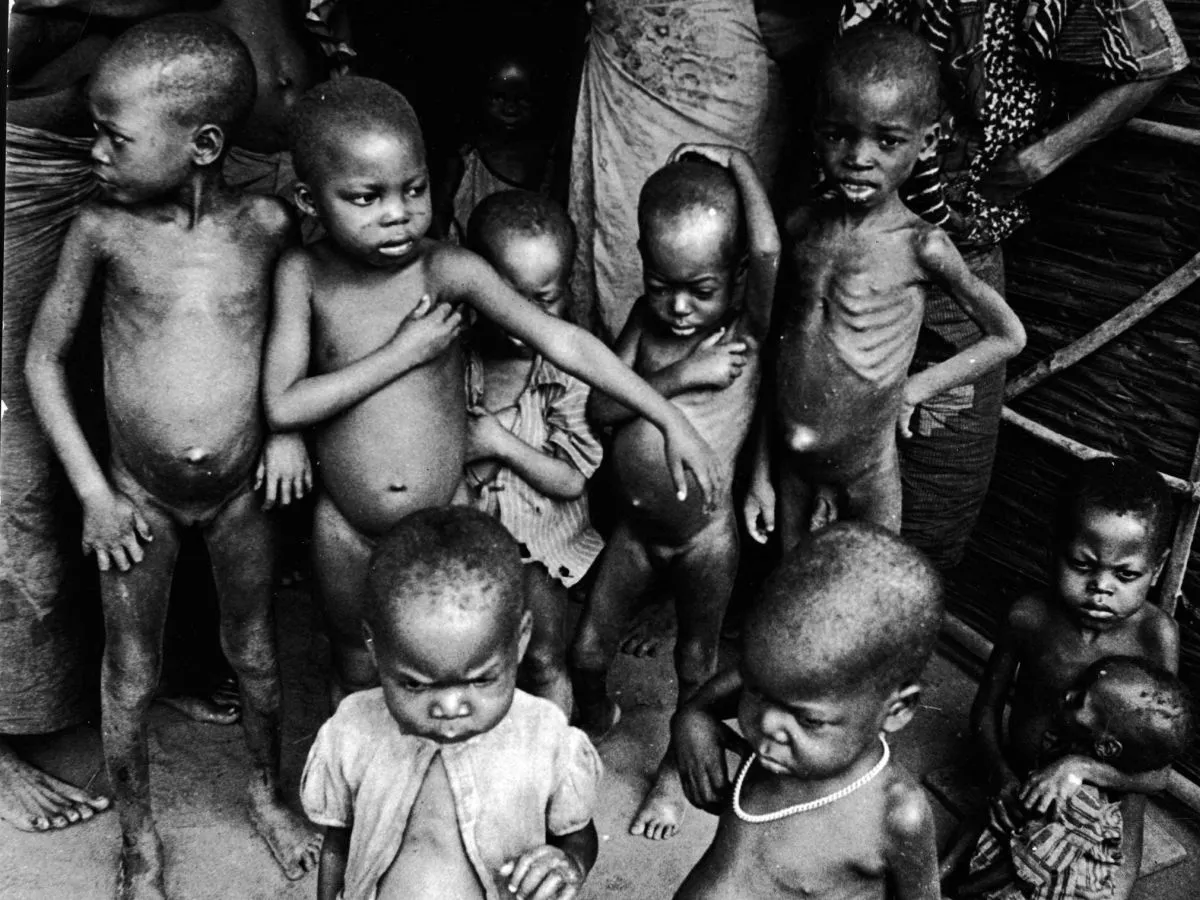
Image: The Independent
From 1998 to 2004, during the Second Congo War, over 3 million people died in the Democratic Republic of the Congo, mostly from starvation and disease.
The Horn of Africa hunger crisis of 2011-12 was responsible for 280,000 deaths in East Africa. 25 million people, including 15 million children, needed humanitarian assistance in East Africa in 2017.
In 218, Africa was home to more than half of the global total of acutely food-insecure people, estimated at 65 million people. East Africa had the highest number at 28.6 million, followed by Southern Africa at 23.3 million, and West Africa at 11.2 million. In 2019, food security deteriorated and it is expected to worsen in the 2020s.
Hunger Woes Africa
Even as Africa has left many shackles behind on its journey to development, hunger is a chain that still restraints many nations on the continent. In Africa, hunger and starvation are escalating at a worrisome pace.
Economic woes, drought, and extreme weather are reversing years of progress so that 237 million sub-Saharan Africans are chronically underfed, more than in any other region.
About 20 percent of the whole of Africa, which is 257 million people, is experiencing hunger. Consecutive bouts of bad crop seasons and poor harvests in Zambia, Zimbabwe, Mozambique, and Angola are taking a toll on agriculture production, and food prices are rising as a result.
In the last three growing seasons, parts of Southern Africa experienced their lowest rainfall since 1981. Various other areas also suffered widespread destruction from Cyclones Idai and Kenneth in March and April 2019, near the time for harvesting.
As a result of these calamities, 41 million people in Southern Africa are facing food insecurity and 9 million people in the region require instant food assistance.
Central Africa has the highest rates of child hunger across the continent, with 48.5 percent of children in the region not having enough food. It’s 32.4 percent in East Africa; 30.9 percent in Southern Africa; 29.5 percent in West Africa; and 12.4 percent in North Africa.
Malnourished Children
According to a study by the African Child Policy Forum (ACPF), almost 60 million children in Africa do not have enough food while across the continent, hunger and starvation contribute to 45 percent of childhood deaths. Moreover, nine out of 10 children are not meeting the criterion for a minimum acceptable diet as outlined by the WHO.
Also Read: Poverty-Stricken Kenyan Mother Boils Stones to Make Hungry Children Stop Crying
The criterion measures the quality, quantity, and how often food is taken, including exclusive breastfeeding, when solid food can be introduced to a diet, and what nutrients should be found in every meal for newborns to children up to 23 months old.
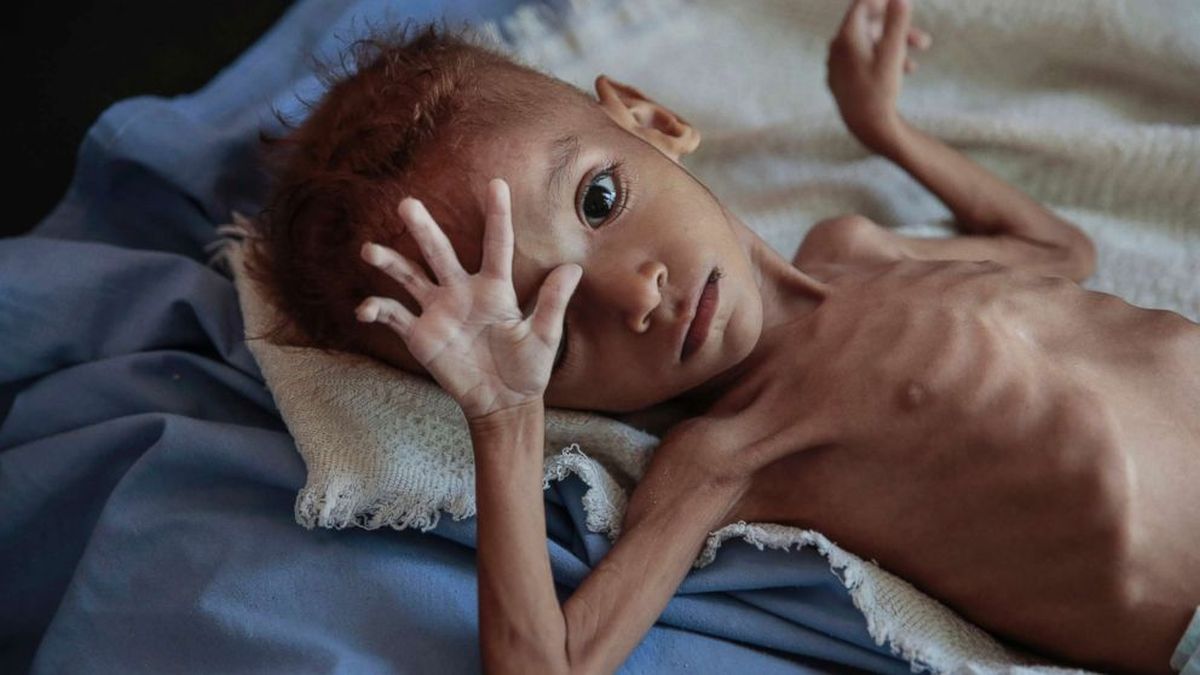
Image: ABC News
A child dies every three seconds globally due to food deprivation – 10,000 children every day – but although figures show an improvement in child hunger at a global level, it is getting worse in some parts of Africa.
Assefa Bequele, ACPF’s executive director, said that child hunger is fundamentally a political problem. Child hunger is born out of the unholy alliance of political indifference, unaccountable governance, and economic mismanagement.
However persistent and naked, this reality remains a silent tragedy, one that is largely unacknowledged and tolerated, mostly as it is a poor man’s problem.
Bequele further added,
It is completely unacceptable that children are still going hungry in Africa in the 21st century. The statistics are truly alarming. Child hunger is driven by extreme poverty, uneven and unequal economic growth, gender inequality and a broken food system. Although Africa now produces more food than ever, it hasn’t resulted in better diets.
Africa could have one billion undernourished, malnourished and hungry children and young people by 2050 if present levels continue undiminished. Over half of African countries are currently off course to meet targets required in the African regional nutrition strategy.
According to ACPF, Mauritius and South Africa are among the states with fewer children suffering from hunger, while the Central African Republic and Chad are the worst child-friendly nations.
Hungry Stomachs in Asia
Despite the rapid economic growth, the Asia-Pacific region has nearly a half billion people who go hungry as progress stalls in improving food security and basic living conditions.
Even in well-to-do cities like Bangkok and the Malaysian capital Kuala Lumpur, poor families cannot afford enough good food for their children, often with devastating long-term consequences for their health and future productivity.
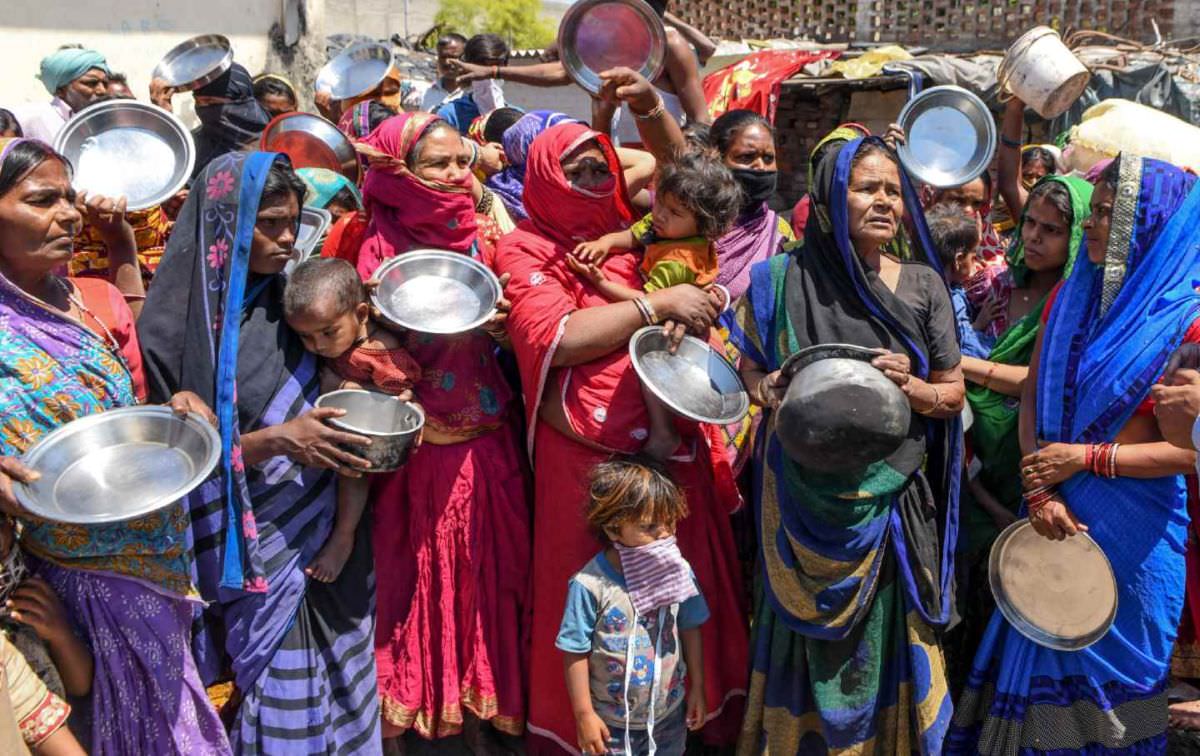
Image: The Nation
In Bangkok, over a third of children were not getting a decent diet as of 2017. In Pakistan, only 4 percent of children were receiving a “minimally acceptable diet.”
According to the regional director-general of the Food and Agriculture Organization (FAO), Kundhavi Kadiresan, to be able to meet the goal of reaching zero hunger in the region by 2030, 110,000 people need to be lifted out of hunger and malnutrition every single day.
Meanwhile, the number of malnourished people in the region has begun to rise, particularly in East and Southeast Asia, with almost no improvement in the past several years.
Global Statistics of Hunger and Starvation
Hunger and starvation across the world have been rising slowly. In the long-term, rates of malnutrition did fall from nearly 18 percent in 2005 to 11 percent in 2017, but hunger-related stunting that causes permanent impairment is worsening because of food insecurity and inadequate sanitation, with 79 million children younger than 5 across the region affected.
Lack of food results in a dangerous rapid weight loss. The condition is seen most often in India and other parts of South Asia but in Indonesia, Malaysia and Cambodia, affecting almost 1 to 10 children in Southeast Asia and 15 percent of children in South Asia.
70 percent of all malnourished children in the world live in Asia. 512 million adults and children in Asia consume too few calories, which accounts for over 12 percent of the total population of Asia.
The Subcontinent of Asia, including India and Bangladesh, has the highest rates, 16 percent, of malnutrition and the most numbers of the hungry in Asia. The Global Hunger Index (GHI) score for South Asia in 2013 decreased by 34 percent compared to the 1990 score.
In 1992, this region accounted for 28.8 percent of the world’s hungry people, however, in 2014 this number rose to 35.4 percent. This is partly owing to a reduced prevalence of hunger in other parts of the world, but also because of an increasing number of hungry people in this region.
In South Asia, 32 percent of all children are moderately or severely underweight, compared to 21 percent in Sub-Saharan Africa, which has the second-highest global rate.
Rural and Underdeveloped Regions Most Affected
98 percent of the world’s hungry people live in developing countries such as Ghana. The highest number of malnourished people, over 520 million, resides in Asia and the Pacific, in countries like Indonesia and the Philippines.
In sub-Saharan Africa, over 243 million people are facing hunger in arid regions such as Ethiopia, Niger, and Mali. Over 37 million people in Latin America and the Caribbean are combating to find enough to eat, in places like Guatemala and Haiti.
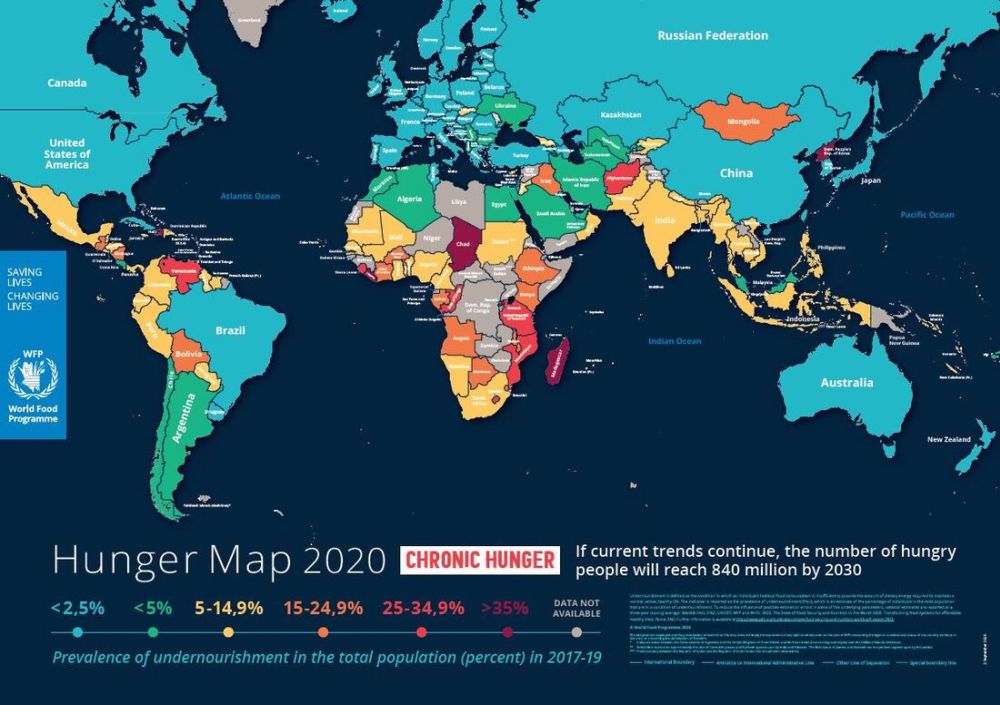
Image: Food Aid Foundation
Most of these people live in rural areas, with agriculture as a primary occupation. As agriculture in most of these regions depends on ample rainfall, the changing climatic patterns are deeply affecting the crop outputs, hence, resulting in vast hunger and starvation of the residents of these regions.
Refugees and people living in conflict zones like Yemen, Syria, and Burkina Faso, and many others that are living hand-to-mouth before the pandemic are particularly vulnerable. These people need humanitarian aid or government assistance that might not have earlier been required.
The current coronavirus pandemic could now double the number of hungry people around the globe, putting an additional 130 million people at risk of suffering acute hunger by the end of 2020, according to the World Food Programme.
Factors Fueling the Problem
Many reports have revealed that climate variability affecting rainfall patterns, agriculture seasons, and climate extremes such as droughts and floods, are among the major key factors contributing to the rise in hunger, together with conflict and economic slowdowns.
Climate changes are already undermining the production of major food crops such as wheat, rice, and maize in tropical and temperate regions. Without building climate resilience, this situation is expected to get much worse as temperatures increase and become more extreme.
According to various reports, the prevalence and number of undernourished people tend to be higher in countries highly exposed to climate change.
Undernourishment is higher when the exposure to climate extremes is compounded by a high proportion of the population depending on the agricultural sector that is highly dependable on rainfall and temperature fluctuations.
The past decade has observed more frequent spells of extreme heat in a long time, which has also altered the rainfall patterns, profoundly affecting the agriculture sector in arid and semi-arid regions.
The adversely affected agricultural production contributes to scarcity in food availability, leading to food price hikes and income losses that reduce people’s access to food.
War and armed conflicts are other major causes of hunger in countries like Sudan, the Democratic Republic of Congo, Yemen, etc.
Since the beginning of the war in Yemen in 2015, around 3.6 million people have been displaced. In war zones, the supply of the most basic goods collapses dramatically as it becomes harder to cultivate fields or run shops.
Famines
The term famine is described as a widespread scarcity of food, caused by several factors such as war, inflation, crop failure, drought or population imbalance. The phenomenon is usually followed by hunger, starvation, epidemic and increase mortality.
During the 19th and 20th centuries, famines were quite a common occurrence, where hundreds of millions of people died from famines across the world.
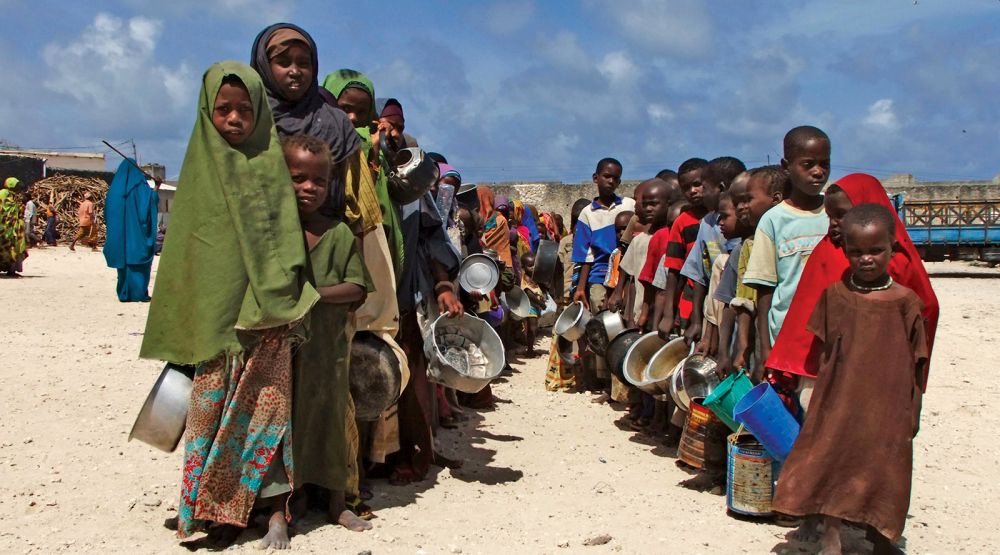
Image: Farah Abdi Warsameh/AP
In the 21st century as well, many countries are either already facing famine, or are on the verge of plunging into one. Coupled with climate change and anthropogenic activities impacting the environment, famines have become so usual that they are barely noticeable anymore.
Afghanistan, Ethiopia, South Sudan, Syria, Yemen, the Democratic Republic of the Congo, Somalia, Venezuela, Northeast Nigeria and Burkina Faso – most of them sufferings from conflicts – have seen a surge in extreme levels of hunger in the past year.
More regions in Asia, Africa and Latin America are expected to face this phenomenon sooner or later with the severity of those during Middle Ages.
Unrest and Conflicts
Food insecurity usually is born in places of famine and conflict zones. A recent report by charitable organization Oxfam has stated that the coronavirus pandemic, climate crisis and conflicts have pushed over half a million people to the brink of starvation.
The number of people facing famine-like situations across the world has increased six-fold over the last year. It also said that cutting new military spending by less than 20 percent can help end the global hunger for good.
Oxfam reported that world hunger is taking more lives than the ongoing pandemic. 11 people die of hunger each minute, outpacing the death toll of the coronavirus pandemic, which has taken the lives of seven people per minute.
Around two-thirds of the 155 million facing hunger live in countries with military conflicts. In countries where the existing food crisis was already at its peak, global hunger is breaking records amid the pandemic.
A recent report by the UN has stated that with the ongoing conflict in Ethiopia’s Tigray, over 400,000 people are suffering from famine now, with 1.8 million on brink of plunging into hunger and starvation. The food insecurity and hunger in the conflict-hit northern Ethiopia region have “worsened dramatically.”
Pandemic Worsens the Situation
With coronavirus pandemic putting millions out of jobs, hunger across the globe is nowhere soon to be gone. The number is escalating by the day and many are expected to die of hunger in the upcoming climatic crisis.
The whole world is facing an unprecedented food crisis rising amid the COVID-19 pandemic. According to WFP’s Chief Economist, the pandemic has caused both severe job losses and major disruptions in food supply chains.
Affording food has become difficult, with millions around the world are losing their jobs or getting their incomes cut. Meanwhile, lockdown measures and trade restrictions are making it harder to transport food from where it’s produced to where it’s needed, resulting in food going to waste in the field and increasing prices of food commodities.
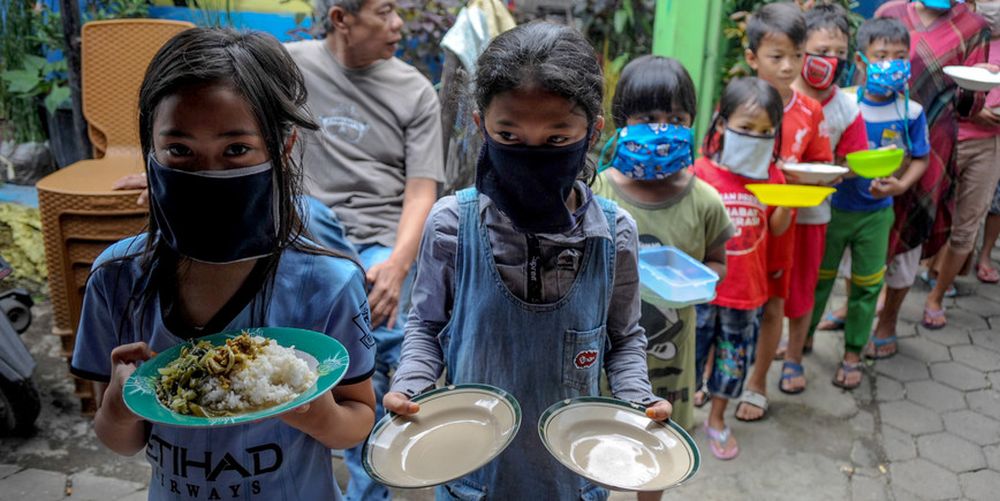
Image: Reuters
Currently, the world does not has a shortage of food, but global food supplies are at risk of running low if farmers are not able to plant in time or receive fertilizer and other inputs in the coming months.
According to a new report from the United Nations, the coronavirus pandemic could push up to 132 million people into hunger by the end of 2020. The report also incorporated the latest version of The State of Food Security and Nutrition in the World, which is published annually by U.N. agencies, including the World Health Organization.
The report stated that an economic recovery, expected in 2021, would bring the number of undernourished people into the picture. The pandemic is adversely affecting the current food supplies and stocks.
As progress in combating hunger stalls, the coronavirus is intensifying the vulnerabilities and inadequacies of global food systems.
Unless the pandemic is controlled or abated, and humanitarian aid is not provided to the people, billions are at risk of starving to death.
Continued Hunger and Starvation Across the World
The greatest obstacle for the SDGs is to eliminate poverty and hunger while maintaining sustainable food security for all in an overcrowded and unequal world. While the global communities have been successful in reducing poverty to some extent, food security and adequate nutrition have not yet been acquired.
According to the statistics of the FAO, the world produces enough food to feed the population of over 7 billion people, and even the estimated 9-10 billion population in 2050. The issue is not the scarcity of food but the poverty and inequity that persist in society.
If we are to eliminate hunger and starvation across the world, a shift is required from a developed model based on charity and aid to one that is based on human rights, reinforced by accountability mechanisms.
Non-discrimination and equality must be accounted for in the entire SDG framework. Marginalized, disempowered, and excluded groups must be factored in development planning, including minorities, migrants, and poor, disabled, older, and indigenous people as well.
Moreover, of those suffering from chronic hunger, 60 percent are females, which is ironic as women do most of the agricultural work in developing countries. The women population has to be included to eradicate hunger while considering their pivotal role in the development and food security.
The hunger persists because we let it stay with us. The human race can eradicate hunger and starvation from the world, the only requirement is to take care of our fellow beings as we would take care of ourselves.
It is imperative to plan and distribute food equally to every stomach and not waste it in these perilous times of changing climate. With renewed compassion for life, we can end the feeling of being hungry once and for all.


